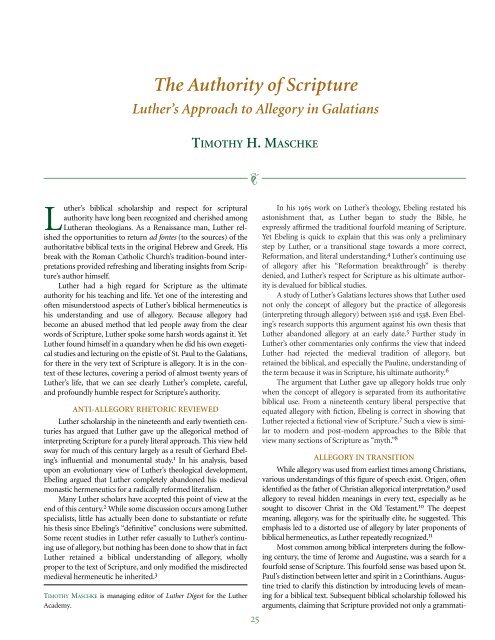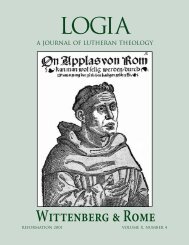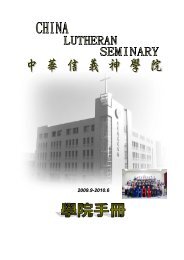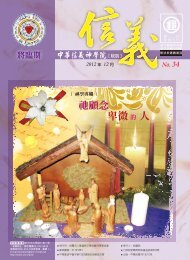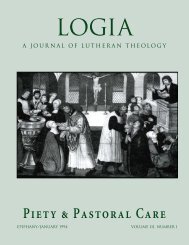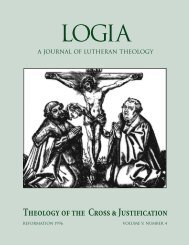Luther’s Approach to Allegory in GalatiansThe Authority of ScriptureTIMOTHY H. MASCHKEmedieval hermeneutic he inherited. 3Luther’s biblical scholarship and respect for scripturalauthority have long been recognized and cherished amongLutheran theologians. As a Renaissance man, Luther relishedthe opportunities to return ad fontes (to the sources) of theauthoritative biblical texts in the original Hebrew and Greek. Hisbreak with the Roman Catholic Church’s tradition-bound interpretationsprovided refreshing and liberating insights from Scripture’sauthor himself.Luther had a high regard for Scripture as the ultimateauthority for his teaching and life. Yet one of the interesting andoften misunderstood aspects of Luther’s biblical hermeneutics ishis understanding and use of allegory. Because allegory hadbecome an abused method that led people away from the clearwords of Scripture, Luther spoke some harsh words against it. YetLuther found himself in a quandary when he did his own exegeticalstudies and lecturing on the epistle of St. Paul to the Galatians,for there in the very text of Scripture is allegory. It is in the contextof these lectures, covering a period of almost twenty years ofLuther’s life, that we can see clearly Luther’s complete, careful,and profoundly humble respect for Scripture’s authority.ANTI-ALLEGORY RHETORIC REVIEWEDLuther scholarship in the nineteenth and early twentieth centurieshas argued that Luther gave up the allegorical method ofinterpreting Scripture for a purely literal approach. This view heldsway for much of this century largely as a result of Gerhard Ebeling’sinfluential and monumental study. 1 In his analysis, basedupon an evolutionary view of Luther’s theological development,Ebeling argued that Luther completely abandoned his medievalmonastic hermeneutics for a radically reformed literalism.Many Luther scholars have accepted this point of view at theend of this century. 2 While some discussion occurs among Lutherspecialists, little has actually been done to substantiate or refutehis thesis since Ebeling’s “definitive” conclusions were submitted.Some recent studies in Luther refer casually to Luther’s continuinguse of allegory, but nothing has been done to show that in factLuther retained a biblical understanding of allegory, whollyproper to the text of Scripture, and only modified the misdirectedTIMOTHY MASCHKE is managing editor of Luther Digest for the LutherAcademy.25In his 1965 work on Luther’s theology, Ebeling restated hisastonishment that, as Luther began to study the Bible, heexpressly affirmed the traditional fourfold meaning of Scripture.Yet Ebeling is quick to explain that this was only a preliminarystep by Luther, or a transitional stage towards a more correct,Reformation, and literal understanding. 4 Luther’s continuing useof allegory after his “Reformation breakthrough” is therebydenied, and Luther’s respect for Scripture as his ultimate authorityis devalued for biblical studies.A study of Luther’s Galatians lectures shows that Luther usednot only the concept of allegory but the practice of allegoresis(interpreting through allegory) between 1516 and 1538. Even Ebeling’sresearch supports this argument against his own thesis thatLuther abandoned allegory at an early date. 5 Further study inLuther’s other commentaries only confirms the view that indeedLuther had rejected the medieval tradition of allegory, butretained the biblical, and especially the Pauline, understanding ofthe term because it was in Scripture, his ultimate authority. 6The argument that Luther gave up allegory holds true onlywhen the concept of allegory is separated from its authoritativebiblical use. From a nineteenth century liberal perspective thatequated allegory with fiction, Ebeling is correct in showing thatLuther rejected a fictional view of Scripture. 7 Such a view is similarto modern and post-modern approaches to the Bible thatview many sections of Scripture as “myth.” 8ALLEGORY IN TRANSITIONWhile allegory was used from earliest times among Christians,various understandings of this figure of speech exist. Origen, oftenidentified as the father of Christian allegorical interpretation, 9 usedallegory to reveal hidden meanings in every text, especially as hesought to discover Christ in the Old Testament. 10 The deepestmeaning, allegory, was for the spiritually elite, he suggested. Thisemphasis led to a distorted use of allegory by later proponents ofbiblical hermeneutics, as Luther repeatedly recognized. 11Most common among biblical interpreters during the followingcentury, the time of Jerome and Augustine, was a search for afourfold sense of Scripture. This fourfold sense was based upon St.Paul’s distinction between letter and spirit in 2 Corinthians. Augustinetried to clarify this distinction by introducing levels of meaningfor a biblical text. Subsequent biblical scholarship followed hisarguments, claiming that Scripture provided not only a grammati-
26 LOGIAcally understandable message (the literal), but a message for one’sfaith (the allegorical), for the believer’s present life (the tropologicalor moral), and also of hope toward which the Christian church wasmoving (the anagogical). 12 Most Bible scholars in the Middle Agesfollowed this pattern of four senses set by Origen, Jerome, andAugustine. They recognized a spiritual quality in Scripture andsought to plumb the depths of the biblical text for its gospel pearls.Aberrations certainly and unfortunately resulted when fervorfor the spiritual sense exceeded ability and sensibility. During thesecenturies, the quadriga (the fourfold approach) not only held sway,but at times became highly rigid and mechanical. The pursuit ofthe multiple senses of Scripture, especially its hidden meanings,created a sense of uncertainty among Bible scholars and caused arift between the use of Scripture and the church’s interpretation.The literal text was not abandoned by all medieval biblicalscholars. The multiple senses were viewed as spiritual applicationsof the literal text according to Bonaventure 13 or as actual meaningsin the literal text according to Nicholas of Lyra. 14 Medieval biblicalscholarship so strongly emphasized the supernatural, spiritualdimension of a biblical text that too frequently the literal text wasignored or only previewed cursorily. 15 The excruciatingly distractingdistortions that accumulated among these Bible interpretersare too numerous for us to mention in this brief article.Misuse of a process or method, however, does not mean thatthat process or method should be abandoned, as the medievalaxiom reminds us: abusus non tollit usum (abuse does not abolishthe use). Luther recognized this truth in several of his renovationmeasures and followed a similar approach to the use of allegoryin his biblical studies. 16 That the quadrigic view of Scripture wasnot always carried out carefully or consistently by others was notthe issue for Luther. Rather his desire was to understand and usethe biblical approach to the Scripture itself so that he could hearGod speak clearly, personally, and authoritatively. 17In his approach to Scripture as his ultimate authority, Lutherrecognized the magnificent richness of God’s Word. This richnessmanifested itself when Scripture was read with an eye toward thegospel and its spiritually vital application to contemporary life.The spiritual use of Scripture, that is, its Christocentric gospelcontent, was clearly recognized and relished as Luther followedhis medieval Bible teachers, who themselves followed the monasticpattern of lectio divina (devotional reading) and read the Wordfor their spiritual nurturing. 18LUTHER’S MONASTIC TRAINING IN ALLEGORYAs a tool for Christian nurture and as a resource of spiritualsustenance, Scripture was part of Luther’s experience in and outof the monastery, before the classroom, and in the pulpit. Just asmonasteries and pulpits had been used and abused, Luther recognizedthat allegory had been misused when separated from theauthoritative biblical text. Yet he also saw that allegory was amethod employed by the biblical authors themselves. Thus hecould neither completely accept it as a fitting approach to Scripturenor categorically reject it out of hand.Luther boldly argued that all mechanical approaches toBible study, especially as they forced mandatory and distinctsenses upon the text, reverted back to a legalistic literalism, afocus on the words, without discovering the Spirit-directedgospel meanings or applications. 19 Following a monastic andAugustinian tradition back to Paul, Luther discovered once againthe spiritual application of a text, the gospel as the true, central,and authoritative message.LUTHER’S UNDERSTANDING OF ALLEGORYThat Luther utilized allegory in his first lectures on Psalms isdemonstrated by a superficial review of his lectures. 20 That herejected a full-blown mechanical quadrigic interpretation in hislater commentaries and lectures is also self-evident. What herejected about allegory and what he retained are not always clear.At least two facts can be pointed out here.First, allegory was used by most scholars of the Middle Agesas a means of underscoring doctrinal content. The distich sooften repeated by monks and cited by Nicholas of Lyra said this inso many words: “Littera gesta docet; quid credas allegoria;Moralis quid agas; quo tendas anagogia.” 21 That there was adeeper sense of application for the Scriptures was not questionedby Luther. Rather, Luther desired to hear the law and the gospelclearly applied. Following his monastic order’s namesake, Augustine,Luther was introduced to the spiritual dimension of Scripture,which freed him from his scholastic, mechanistic teachers.He had experienced the dire dread created by the law, that pedagoguewhich functioned only for a time, and rejoiced in a gospelthat freed him from his sins as well as his doubts and despair. 22Instead of seeking four distinct meanings, Augustine enabledLuther to seek only the basic two levels of meaning: the historicalgrammaticaltext and the spiritual-personal application, or thehuman side and the divine side of Scripture. 23Allegory was used by most scholars ofthe Middle Ages as a means of underscoringdoctrinal content.nbLuther began to understand the need for an authoritative historical-grammaticalreading of the biblical text and made a breakwith the mechanical use of the quadriga. Although allegory wastheoretically always under the direct interpretation of the churchthrough the analogy of faith, that particular approach had not beensufficiently practiced by many in the Middle Ages. During the timethat Luther grew away from the church’s authority, he also grewaway from the use of allegory as a method merely to support biblicaldoctrine. He discovered that such a mechanical attempt tointerpret every text allegorically had confounded the doctrine andmade the Bible a closed book, open only to those experts who hadunderstood the doctrines of the church and then could, through aprocess of eisegesis, read the doctrines back into the texts.What Luther recovered from his reading of Augustine, andmore importantly from Paul, was that Scripture not only revealedthe basic literal information, but that there was an authoritativespiritual sense that every Christian needed to apply to his ownlife, the law and the gospel. 24


